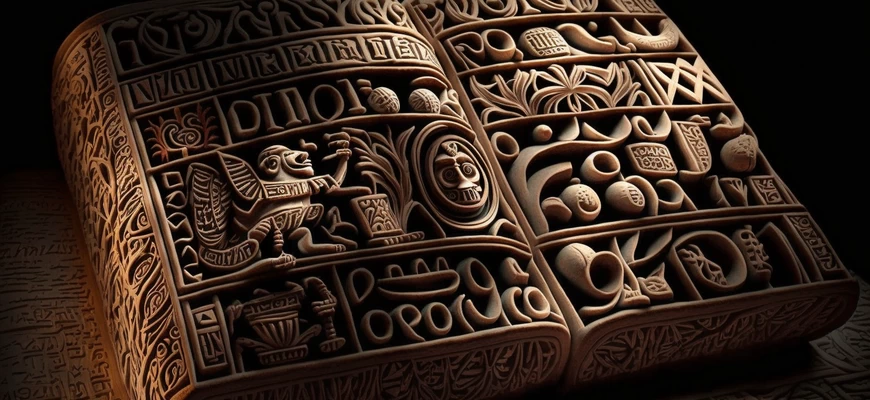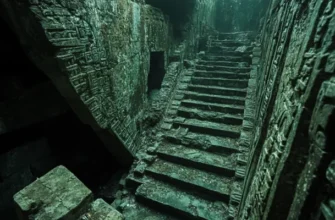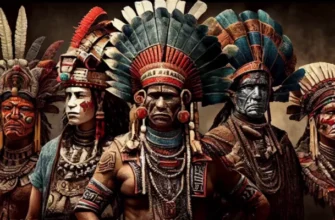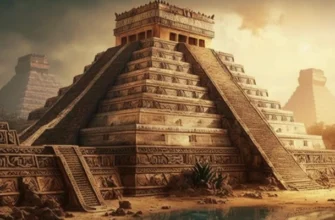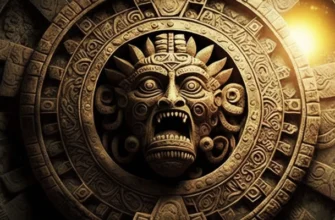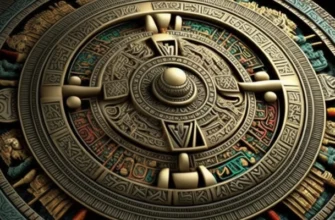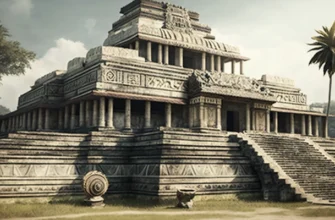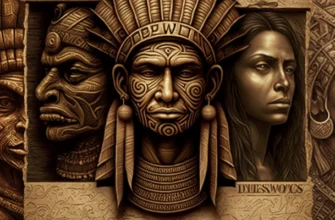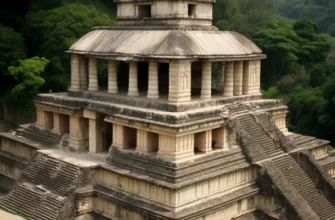The Mayan script is a complex writing system used in Mesoamerica for many centuries. Symbols can have hieroglyphic, logographic, and phonetic meanings. The Mayan writing system had a significant impact on the culture and society of the region.
Historical context
The Maya writing system developed in the Mesoamerican region, which includes the territory of modern Mexico, Guatemala, Belize, and parts of Honduras and El Salvador. This writing system was used for a long period, from about the 3rd millennium BC to the beginning of the colonial period in the 16th century. The Mayan script was an important part of the culture of these peoples, and was used for a variety of purposes, including religious and astronomical rites, as well as for recording history and literary works.
Early forms of writing
Early Mayan writing forms consisted of simple geometric symbols such as circles, lines, and triangles used to represent various objects and ideas. Over time, these symbols became more complex and abstract, allowing for the development of a more sophisticated writing system. There were several types of symbols in Mayan writing, including hieroglyphs (representing a whole word), logographs (representing a word with another word with a similar sound), and phonetic symbols (representing sounds or syllables of words). The early forms of Mayan writing were an extremely important step in the development of this writing system and played an important role in shaping Mayan culture and civilization.
Development of the writing system
The Mayan writing system evolved over many centuries, with many new symbols and ideas emerging. During the Classic period (250-900 AD), the Mayan script became more complex and detailed. The new symbols made it possible to record more complex concepts and ideas, such as dates and names of people.
During the Postclassic period (900-1521 CE), the Mayan script suffered some decline due to political and social changes in the region. However, the Mayan script continued to develop in some areas where Mayan peoples preserved their culture and language. Today, scholars continue to research and decipher the remains of the Mayan script to gain more information about this ancient civilization and its culture.
Symbols and their meanings
The Mayan writing system used a complex system of symbols that consisted of more than 800 different signs. Some of them had a hieroglyphic meaning, meaning they represented specific ideas or objects, while other symbols were used to record numbers, calendars, and astronomical events.
Here are some of the most important symbols and their meanings in the Mayan script:
The glyph “Ajaw” – represents a king or authority, and also denotes a day in the Mayan calendar.
The Chaac glyph represents the rain god and the Mayan water calendar.
The glyph “K’in” represents a day in the Mayan calendar and is used to write numbers.
The Ch’ab glyph represents a month in the Mayan calendar.
The K’atun glyph denotes a period of 20 years in the Mayan calendar.
The glyph “Imix” represents the beginning of the Mayan calendar and the god of wisdom.
The glyph “Kukulkan” represents the god Sail, who was important in Mayan astronomy and calendar.
The Itzamna glyph represents the main god of Mayan mythology, who was considered the god of wisdom and knowledge.
These are just a few examples of the many different symbols used by the Maya. Each symbol had its own unique meaning and was used to record different ideas, concepts, and events.
Hieroglyphs
Hieroglyphics are a writing system used in ancient times in various cultures, including Egypt and Mesopotamia. The Mayans also had their own writing system, which consisted of hieroglyphs.
The Mayan script contained more than 800 characters, which were combinations of different images that were supposed to represent certain ideas, words, or sounds. Unlike alphabetic writing systems, where each symbol corresponds to a sound or letter, Mayan hieroglyphs can have different meanings depending on the context.
The Mayan script was used to record various types of information, including history, religion, mathematics, and astronomy. Most texts were written on papyri or on the walls of palaces and temples.
Much of the knowledge of the Mayan script has now been reconstructed through the decipherment of hieroglyphics, as well as through other sources such as maps and images on vases and statues. Although much of the information recorded by the Maya has been lost, this writing system is still considered an important source of research for the study of Mayan culture and civilization.
Logographs
Logographs are symbols used in writing systems to represent whole words or ideas. In Mayan writing, there were logographic symbols that represented certain ideas or words.
There were many logographic symbols in the Mayan writing system that were used to represent different things, such as plants, animals, tools, geographical locations, and other objects and ideas. These symbols were used together with other hieroglyphic characters to compose messages and texts.
For example, the crocodile symbol has been used to represent the idea of a crocodile and also to represent some of the sounds contained in words that refer to a crocodile. However, in most cases, logographic symbols have not been used to represent sounds, but only to represent specific ideas or objects.
Although logographs are not used in modern language, they were an important element of the Mayan writing system and helped to record information in a more efficient and compact way.
Phonetic symbols
Phonetic characters are symbols used to represent the sounds that make up words. The Mayan writing system had phonetic symbols that helped to record language using signs that represented sound values.
There were many phonetic symbols in the Mayan writing system that were used to represent different sounds and syllables. These symbols had different shapes that represented different sounds. For example, the “a” symbol represented the sound [a], the “e” symbol represented the sound [e], and the “ch’a” symbol represented the sound [tʃʼa].
Phonetic symbols were an important element of the Mayan writing system because they allowed for the recording of sound speech using signs. This helped the Maya keep records of their history, religion, and culture. However, the recovery of the Mayan script has been a difficult task, as many of the phonetic symbols remained unknown until enough inscriptions were found to decipher them.
Writing methods
The Mayan script used a variety of writing methods. The main writing methods used in Mayan writing include hieroglyphs, logographs, phonetic symbols, and glyphs.
Hieroglyphs are complex symbols used to represent various ideas, concepts, animals, plants, and other objects. In the Mayan writing system, there were hieroglyphs that represented concepts such as the sun, moon, water, fire, and others. Hieroglyphs were an important element of the Mayan writing system and were used to represent complex ideas and concepts.
Logographs are symbols used to represent whole words or ideas. There were many logographic symbols in the Mayan writing system that were used to represent different things, such as plants, animals, tools, geographical locations, and other objects and ideas.
Phonetic symbols are symbols used to represent the sounds that make up words. In the Mayan writing system, there were many phonetic symbols used to represent different sounds and syllables.
Glyphs are complex symbols made up of several hieroglyphs, logographs, and phonetic symbols. Glyphs were used to represent complex ideas and concepts, such as names, dates, cosmic phenomena, and others.
The use of different recording methods helped the Maya to keep a variety of documentation, including histories, religious and cosmological easter eggs, mathematical and astronomical tables, as well as event schedules and administrative records.
The Mayan writing system was a complex instrumental system with many different writing methods used depending on the type of document and its purpose. Although most of the original documents written in the Mayan script have not survived, much information about the script has been recovered from a variety of sources, including the walls of pyramids and other buildings, artifacts that have been discovered during archaeological excavations, and collections held in museums and libraries around the world.
Despite the complexity of the Mayan script, it remains an amazing sounding board for the study of art, history, mathematics, astronomy, and other fields of knowledge, helping to preserve the cultural heritage of these ancient and fascinating people.
Glyphic writing
Glyphic writing in the Mayan script was the use of hieroglyphs to represent individual words or ideas. Each glyph could represent a single word, phrase, or idea, and often consisted of a combination of logograms and phonetic signs.
Glyphs could have different shapes and sizes, depending on their meaning. For example, a glyph that stood for the name of a ruler might be large and complex in configuration to emphasize his importance and status. A glyph that represented a certain idea or concept might have a simpler shape and smaller size.
In addition to logograms and phonetic signs, glyphs could include other elements such as calendar symbols, pictographs, and hieroglyphs to represent specific ideas or concepts.
In Mayan writing, glyphs can be written in both vertical columns and horizontal lines. The glyphs can be placed next to each other or even nested within each other.
Glyphic writing was one of the most important recording methods in the Mayan script, which allowed for the expression of complex ideas and concepts. However, the study and decipherment of Mayan texts remains challenging due to the complexity and variety of glyphs, their meanings, and contexts.
Deciphering the writing system
The Maya writing system is a complex writing system used by the ancient Maya people to record their language and cultural achievements.
The system consists of more than 800 hieroglyphs, each of which can have several meanings. Hieroglyphs can represent objects, animals, plants, people, symbols, and abstract concepts. These hieroglyphs can be written both with the help of pictograms, i.e. images of objects, and with the help of glyphs that express the sound component of the language.
The Mayan writing system has not yet been fully deciphered, as many of the hieroglyphs remain a mystery. However, some scholars have made significant progress in decoding this system by studying the hieroglyphs, their meanings, and the context in which they were used.
Today, some archaeological sites that contain Mayan inscriptions have been successfully deciphered, providing more information about this ancient civilization. However, many aspects of the Mayan writing system remain a mystery, and scholars continue to work on deciphering this interesting and complex writing system.
Interpreting the texts
Interpreting Mayan texts is a difficult task, as many of the meanings of the hieroglyphs remain unknown. However, scholars have made significant progress in the study of this writing system and its interpretation.
One of the main sources of information about the Maya is claymation books, which contain stories, myths, religious rituals, and other important aspects of their culture. Interpreting the texts of these books requires a careful study of the hieroglyphs and their context, as well as knowledge of Mayan culture and language.
One of the key principles of interpreting Mayan texts is a careful study of the context. Most hieroglyphs have multiple meanings, so it is important to understand the context in which they are used. For example, an image of an animal can have different meanings depending on the context in which it appears.
Another important aspect of interpreting Mayan texts is learning the Mayan language. Some hieroglyphs represent phonetic meanings, i.e. they express the sound component of the language. Other hieroglyphs represent logographic meanings, meaning they express the meaning of a word without reproducing its sounds. Understanding the different types of hieroglyphs helps scholars decipher Maya textual sources.
Epigraphy research
The epigraphy of the Maya script is the science that studies the inscriptions and hieroglyphics that were left on Mayan monuments. This science helps to restore the history and culture of the Maya, reveals their religious worldview and social organization.
The study of Maya epigraphy includes several stages. The first stage is to unravel the hieroglyphs and find out their meaning. This is a very difficult process, as there are more hieroglyphs in the Mayan script than in any other writing. For example, there are more hieroglyphs in the Mayan script than in the Egyptian script.
The second step is to determine the context in which these hieroglyphs were used. This can help establish the meaning of specific phrases and reconstruct the text as a whole.
The third stage is the analysis of the studied texts. This allows us to identify important events and dates that were recorded on Mayan monuments. It is also possible to determine which individuals and events were of great importance to the Maya.
The study of Maya epigraphy can provide a lot of new knowledge about this civilization, its culture, religion, and history. For example, research can help to establish why the Maya disappeared or help to recover the text of ancient religious texts. It is also possible to recover information about the conquest of the Maya tribes by other peoples.
It is emphasized that Mayan epigraphy is a very important source of information about this ancient civilization. However, its study is a difficult task, since inscriptions on Mayan monuments have survived in limited numbers and were made on different materials, which may affect their preservation and readability.
In addition, there are different opinions on the interpretation of hieroglyphs and texts on Mayan monuments, which can lead to different interpretations and disagreements in determining specific events and dates.
Nevertheless, Maya epigraphy remains an important source of information for the study of this civilization, and continued research in this area may bring new knowledge and understanding about the Maya.
Conclusions
A writing system is a set of symbols used to convey information through written communication. Depending on the country or region, writing systems may use different alphabets, symbols, and grammatical rules.
For example, the Latin alphabet, which is used in most Western countries, consists of 26 letters. At the same time, the Chinese writing system uses thousands of characters.
In addition, each writing system has its own rules for using characters and grammar. For example, in English, there is a rule of sentence division that helps the reader better understand the text. At the same time, Chinese does not have a similar rule, so understanding the text depends on the context.
The writing system is an important element of a country’s or region’s culture, as it conveys not only information but also cultural and historical values. For example, in Chinese, each character has its own meaning and reflects the peculiarities of Chinese culture.
There are many different writing systems in the world, and each of them has its advantages and disadvantages. However, despite this, writing systems are an integral part of our culture and facilitate effective communication between people from different countries and cultures.
